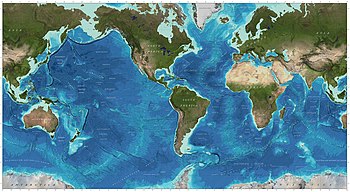Animals In The Neritic Zone

As highlighted in light green, the neritic zone coincides with the relative shallows of the continental shelves
The neritic zone (or sublittoral zone) is the relatively shallow part of the ocean above the drop-off of the continental shelf, approximately 200 meters (660 ft) in depth.[1] [2] From the point of view of marine biology information technology forms a relatively stable and well-illuminated environs for marine life, from plankton upward to large fish and corals, while physical oceanography sees it every bit where the oceanic system interacts with the declension.
[edit]
In marine biology, the neritic zone, also chosen coastal waters, the coastal ocean or the sublittoral zone,[3] refers to that zone of the sea where sunlight reaches the bounding main floor, that is, where the water is never so deep as to have information technology out of the photic zone.
Information technology extends from the depression tide mark to the edge of the continental shelf, with a relatively shallow depth extending to about 200 meters (660 anxiety). Above the neritic zone lie the intertidal (or eulittoral) and supralittoral zones; below it the continental gradient begins, descending from the continental shelf to the abyssal plain and the pelagic zone.
Inside the neritic, marine biologists also identify the following:[ citation needed ]
- The infralittoral zone is the algal-dominated zone downwards to around five metres below the low water mark.
- The circalittoral zone is the region beyond the infralittoral, which is dominated by sessile animals such as oysters.
- The subtidal zone is the region of the neritic zone which is below the intertidal zone, therefore never exposed to the temper...........
Concrete characteristics [edit]
The neritic zone is covered with generally well-oxygenated water, receives enough of sunlight, is relatively stable temperature, has low water pressure and stable salinity levels, making it highly suitable for photosynthetic life. There are several different areas or zones in the ocean. The expanse forth the bottom of whatsoever body of h2o from the shore to the deepest abyss is chosen the benthic zone. It is where decomposed floral and faunal debris (also known as ocean 'snow') has settled to form a sediment layer in which various plants can grow. All photosynthetic life needs lite to grow and how far out into the ocean light tin still penetrate through the water column to the floor or benthic zone is what defines the neretic zone. That photic zone, or area where lite can penetrate through the water cavalcade, is ordinarily above ~100 meters (~328 feet). Some littoral areas have a long expanse of shallow h2o that extends far out beyond the landmass into the water and others, for example islands that accept formed from ancient volcanos where the 'shelf' or edge of the land mass is very steep, have a very short neritic zone...
Life forms [edit]
The higher up characteristics make the neritic zone the location of the majority of sea life.[4] The outcome is high principal production by photosynthetic life such every bit phytoplankton and floating sargassum; zooplankton, free-floating creatures ranging from microscopic foraminiferans to small fish and shrimp, feed on the phytoplankton (and one another); both trophic levels in turn class the base of the food concatenation (or, more properly, web) that supports most of the earth's great wild fisheries. Corals are also mostly institute in the neritic zone, where they are more than common than in the intertidal zone equally they have less change to deal with.
Definition (physical oceanography) [edit]
In physical oceanography, the sublittoral zone [or "neritic"? clarification needed ] refers to coastal regions with significant tidal flows and energy dissipation, including non-linear flows, internal waves, river outflows and ocean fronts.[ citation needed ] As in marine biology, this zone typically extends to the edge of the continental shelf.
See as well [edit]
- Coastal fish
References [edit]
- ^ anon. (n.d). Ocean Regions: Bluish H2o – Characteristics. Available: "Body of water Regions: Blue H2o - Characteristics". Archived from the original on 13 December 2007. Retrieved xx January 2012. . Concluding accessed fifteen May 2014.
- ^ Rizk, F. (n.d). MARINE ENVIRONMENT AND Master PRODUCTIVITY. Available: "Master Productivity". Archived from the original on 9 November 2014. Retrieved 15 May 2014. . Last accessed 15 May 2014.
- ^ Experts, A. Squad Of (January 2000). Advanced Learner S Dictionary Botany. ISBN9788126104611 . Retrieved 10 Feb 2016.
- ^ Function of Naval Research Archived thirteen Dec 2007 at the Wayback Machine
Animals In The Neritic Zone,
Source: https://en.wikipedia.org/wiki/Neritic_zone
Posted by: shawthadell.blogspot.com


0 Response to "Animals In The Neritic Zone"
Post a Comment